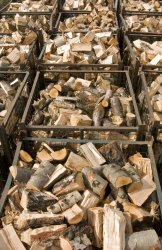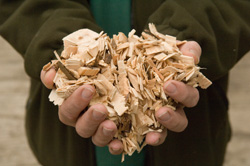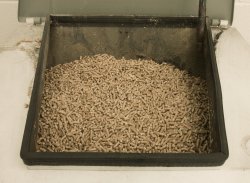The simplest form of woodfuel, requiring little specialist equipment to prepare. Consequently lends itself well to self-supply. However, does not lend itself to an automated heating system.
Allows a fully automated heating system, and also potential for self-supply, however a specialist, woodfuel quality chipper is required, and large volume storage.
Clean, free flowing, high energy density, allowing a fully automated heating system with sophistication on a par with the best fossil fuel systems. Delivered by tanker, but no option for self supply.
An alternative to firewood that is dryer, denser and cleaner, especially suitable for those with limited storage space. Lacks the “natural” look of traditional firewood.
The simplest, and most traditional form of woodfuel is firewood logs. The only processing required is drying and cutting to a size that conveniently fits in your stove or boiler.

Firewood logs have the big advantage as a fuel that they can be sourced from one’s own woodland or trees with minimal specialist equipment other than a chainsaw and appropriate protective equipment. Owing to the physical size of the pieces it is critical that it is dried thoroughly, usually down to 20-25% moisture content (wet basis), which typically requires seasoning for two years.
See the Equipment section for information on suitable stoves and boilers for burning logs.
Small round wood (SRW) may simply be cut into logs. This may be done in the forest for ease of extraction and handling and to assist drying, and involve de-limbing and cutting into logs of typically 2-3 m in length.
These may be stacked at the roadside for convenience of subsequent collection, which may follow a period of drying. On average 1 m3 of roundwood requires 1 linear metre of roadside space.
If well stacked, a pile of round and split logs can show a bulk density 70% of that of the solid wood, though if loose this can drop to only 40% or less.
Scoring or partial removal of bark may help to accelerate drying. For logs over 15 cm diameter splitting is recommended to assist drying.
Logs may also be sold directly to domestic consumers as fire wood logs to be burned in an open fire or log burner. For this they need to be around 15-50 cm long (for many domestic users 25-30 cm is the optimum) and typically split if greater than 10 cm diameter.
Wood chips offer the advantage over logs that they can be fed automatically into a boiler. This makes them suitable for larger boilers, however they are a relatively bulky fuel so require a large fuel store.
 Advantages over logs
Advantages over logsAlthough logs can be stored and transported conveniently when stacked, and the ease of air passage through a log pile allows good drying, they are not suited to automated handling and feeding. Also, the relatively small surface area to volume ratio makes efficient combustion or gasification difficult to achieve.
Wood chips can form a much more uniform fuel that can flow and can be fed to a boiler, gasifier or other conversion system as a steady flow using an auger feed or a conveyor. With a large surface area to volume ratio they can also be burned very efficiently.
Depending on the equipment they are to be used with, wood chips typically have the longest dimension between 20 mm and 50 mm, though larger chips (known as hog fuel), and chunks can be 100 mm or more. Long thin pieces (slivers) amongst the chips should be avoided as they can cause bridging and blockages in a chip feed system.
To produce chips suitable for most boilers requires a specialist chipper designed for woodfuel use to produce chips of even size that will flow well and ensure there are no long slivers that can cause jams or bridging. A general purpose chipper is not suitable.
Wood chips should be stored under cover to prevent wetting, however good airflow is necessary to disperse water vapour and minimize the chance of composting and mould formation.
In addition, stack height should be kept below 10 m to prevent heat build up from composting and the potential for spontaneous combustion.
Wood chips may have a bulk energy density of about 40-50% of that of the solid wood.
Wood chips for energy applications should meet an appropriate quality standard if they are to be used reliably in combustion equipment, especially small scale and domestic equipment. Physical parameters, such as maximum size and absence of slivers or fines (sawdust), and maximum moisture content are important to allow reliable operation and prevent feed blockages. Also levels of contaminants and ash content will have an impact on emissions and maintenance schedules.
The British standards for solid biomass, including wood chips, allow all of these parameters, and acceptable ranges, to be defined.
The characteristics of wood chips will depend both on the chipper and the material from which they are made. They can be divided into groups:
Wood pellets are a clean, free flowing form of woodfuel that can be delivered by tanker through a hose and allow a fully automatic heating system.
 What are wood pellets
What are wood pelletsWood pellets are made from dry sawdust compressed under high pressure and extruded through a die. They may include a low level of added binder, such as starch, but many use nothing other than steam.
They come in a range of sizes: for domestic and relatively small scale systems 6 or 8 mm is typical, while for larger systems 10 or 12 mm are common.
Wood pellets should be dry, clean, mechanically robust and have an ash content defined by the appropriate standard (see below) to which they have been made, which may also define other contaminants such as chlorine content.
They should also flow freely and can be delivered via a pneumatic system.
The combination of low moisture content (8-10%) with a compressed, dense pellet (typically >1,000 kg/m3, i.e. greater than the original wood) and the ability to flow and pack closely, gives a fuel with a high bulk energy density. This then requires less storage space than lower density fuels such as wood chips.
Wood pellets also provide an alternative, renewable and low carbon alternative to fuel old coal boilers.
Commercial conversion kits are available, but some systems are being run with few modifications other than to the fuel feed which needs to be higher owing to the lower energy density of wood pellets.
Where coal is in use storage and handling infrastructure for a solid fuel will already be in place. Wood pellets provide a fuel that, in addition to its environmental benefits, is cleaner, more pleasant to handle, is less aggressive to fuel handling components such as augers, and produces considerably less ash.
A coal storage bunker will hold enough pellets for operation for around one half to a third of the time possible with the same volume of coal.
Standardized fuel specifications are critical to the efficient and reliable operation of pellet boilers and stoves. BS EN 14961-1 sets out the general specifications and classes of solid biofuels. BS EN 14961-2 sets out a specific set of specifications and classes for non-industrial wood pellets. This includes parameters such as ash content and mechanical durability. Pellets defined according to this are described as EN Plus pellets.
Wood pellets are a commodity fuel, traded internationally. Their manufacture cannot be realistically undertaken on a small scale or DIY basis. Self-supply is therefore not a realistic option.
Wood pellets have a higher embedded energy than woodchips, owing to the energy needed to grind the wood to fine sawdust (typically in a hammer mill) and press it through a die at high pressure. The energy (and financial) cost of active drying is not usually justified, however they do allow low value waste wood residues, such as sawdust, to be made use of.
Avery low moisture content (typically <14%) is required of the sawdust feedstock, so many pellet production facilities are established where there is an existing supply of very dry material, such as were processing of wood that is already kiln dried takes place. For example:
This also removes the need to transport the very low density sawdust. Where a supply of bone dry sawdust is available, this may be supplemented with sawdust of higher moisture content provided the overall moisture content does not become too high. The precise embedded energy figure for a batch of pellets will depend on the details of production (plus that of the feedstock), especially drying, and transport etc.
Fuel pellets can also be made from a number of other forms of biomass, including Miscanthus, straw, and various forms of biomass residues. Although these are all perfectly acceptable types of biomass fuel pellet, they have different properties, especially combustion properties, and require suitable, specialist combustion equipment to burn them safely and efficiently. If burned in inappropriate equipment, not designed for this fuel, they can cause damage that is not likely to be covered by the warranty.
In suitable equipment however, they can be burned entirely satisfactorily, and are likely to be cheaper than conventional wood pellets.
Various forms of biomass, such as wood shaving, can be compressed into briquettes of roughly the size and shape of conventional firewood logs. Although similar to logs, they are typically dryer and more dense.
Briquettes are similar to wood pellets, but physically larger. Sizes vary but briquettes can vary in diameter from around 50 mm to 100 mm or more. Briquettes are usually between 60 mm and 150 mm in length. They can offer a cleaner, more consistent alternative to firewood logs, offering higher energy density and steady combustion.
Wood briquettes, made from wood shavings, are the most common, but briquettes made with other forms of biomass are available, including miscanthus.
Briquettes are typically used in place of firewood logs. Owing to the higher energy density they are particularly suitable where storage space is limited, and tend to be cleaner than traditional logs. They are also more consistent, and burn more steadily, however different briquettes are deliberately manufactured with different burning characteristics for different markets.